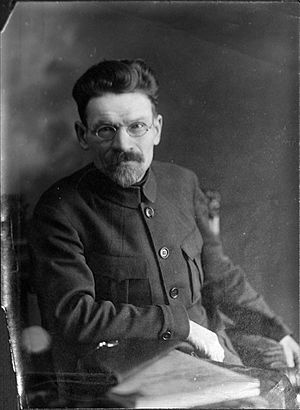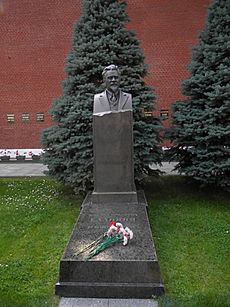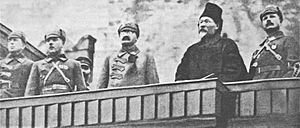Mikhail Kalinin facts for kids
Quick facts for kids
Mikhail Kalinin
|
|
|---|---|
|
Михаил Калинин
|
|

Kalinin in 1920
|
|
| Head Of State of the Soviet Union | |
| In office 17 January 1938 – 19 March 1946 |
|
| Deputy | Nikolai Shvernik |
| Preceded by | Position established |
| Succeeded by | Nikolai Shvernik |
| Chairman of the Central Executive Committee of the Soviet Union (shared) |
|
| In office 1922–1938 |
|
| Chairman of the Central Executive Committee of the All-Russian Congress of Soviets | |
| In office 30 March 1919 – 15 July 1938 |
|
| Preceded by | Mikhail Vladimirsky (acting) Yakov Sverdlov |
| Succeeded by | Position Abolished Aleksei Badayev as Chairman of the Presidium of the Supreme Soviet of the Russian SFSR |
| Full member of the 15th, 16th, 17th, 18th Politburo | |
| In office 1 January 1926 – 3 June 1946 |
|
| Member of the Orgburo | |
| In office 16 March 1921 – 2 June 1924 |
|
| Candidate member of the 8th, 9th, 10th, 11th, 12th, 13th, 14th Politburo | |
| In office 25 March 1919 – 1 January 1926 |
|
| Personal details | |
| Born |
Mikhail Ivanovich Kalinin
19 November 1875 Verkhnyaya Troitsa, Tver Governorate, Russian Empire |
| Died | 3 June 1946 (aged 70) Moscow, Russian SFSR, Soviet Union |
| Resting place | Kremlin Wall Necropolis, Moscow |
| Nationality | Soviet |
| Political party |
|
| Spouse | Ekaterina Ivanovna Lorberg-Kalinina |
| Occupation | Civil servant |
| Signature | |
Mikhail Ivanovich Kalinin (Russian: Михаи́л Ива́нович Кали́нин; 19 November 1875 – 3 June 1946) was an important Soviet politician and a revolutionary. He was the official head of state for the Russian Soviet Federative Socialist Republic and later for the entire Soviet Union from 1919 to 1946. From 1926, he was also a member of the Politburo, a powerful group within the Communist Party of the Soviet Union.
Born into a farming family, Kalinin started as a metal worker in Saint Petersburg. He joined the Bolsheviks early on and took part in the 1905 Russian Revolution. After the October Revolution, he became the mayor of Petrograd (which is now St. Petersburg). He then rose to become the official head of the new Soviet state.
Even though he was the official head of state, Kalinin had little real power after Joseph Stalin became the main leader. He retired in 1946 and passed away that same year. A city in what was once East Prussia, Königsberg, was renamed Kaliningrad in his honor after the Soviet Union took control of it in 1945. The city of Tver was also called Kalinin until 1990.
Contents
Early Life and Beginnings
Mikhail Ivanovich Kalinin was born on 19 November 1875. His family were farmers in a village called Verkhnyaya Troitsa in Tver Governorate, Russia. He was the older brother of Fedor Kalinin.
Kalinin finished school in 1889 and worked on a farm for a while. In 1895, he moved to Saint Petersburg and found a job as a metal worker. He also worked as a butler and later as a railway worker in Tbilisi. There, he met Sergei Alliluyev, whose daughter would later marry Joseph Stalin.
In 1906, he married Ekaterina Lorberg, who was from Estonia. She changed her last name to Kalinina after they got married.
Joining the Revolution
Kalinin joined the Russian Social Democratic Labour Party (RSDLP) in 1898, the year it was formed. He became friends with Stalin through the Alliluyev family.
During the Russian Revolution of 1905, Kalinin worked for the RSDLP. He was also active in different cities like Tiflis (now Tbilisi), Reval (now Tallinn), and Moscow. In 1906, he attended an important meeting of the RSDLP.
Kalinin was a strong supporter of the Bolshevik group, led by Vladimir Lenin. In 1912, he attended a Bolshevik Party meeting in Prague. He was chosen as a backup member for the main governing group, the Central Committee.
He was arrested in 1916 during World War I for his political activities. However, he was set free during the February Revolution of 1917.
A Leader in the New Soviet State
After his release, Kalinin joined the Bolshevik committee in Petrograd. He helped organize the party's daily newspaper, Pravda, which was now allowed to be published.
In April 1917, Kalinin believed in working with the temporary government that was in power. This was different from Lenin's view. He also did not support an armed uprising to remove the government that summer.
In the autumn of 1917, Kalinin was elected mayor of Petrograd. He managed the city during and after the October Revolution on 7 November.
In 1919, Kalinin became a member of the main governing group of the Russian Communist Party. He also became a candidate member of the Politburo. In January 1926, he became a full member of the Politburo and stayed in this position until he died in 1946.
When Yakov Sverdlov died in March 1919, Kalinin took his place as the President of the All-Russian Central Executive Committee. This made him the official head of state of Soviet Russia. The name of this position changed over time, but Kalinin held it without a break until he retired after World War II.
In 1920, Kalinin attended a major international meeting of communist parties in Moscow. He was an active participant in the discussions.
Life Under Stalin
Kalinin supported Joseph Stalin during the power struggles after Lenin's death in 1924. He was one of the few people in Stalin's close group who came from a farming background. The official news often called him the "All-Union Elder," which connected him to the idea of a wise village leader.
Even though he was a member of the Politburo and held a high official position, Kalinin did not have much real power. His job was mostly to receive official letters from other countries. Later, Soviet leader Nikita Khrushchev said that Kalinin mostly signed official papers but rarely took part in important government decisions.
Kalinin's wife, Ekaterina Kalinina, was arrested on 25 October 1938. She was critical of Stalin's policies. At the time, Ekaterina and Mikhail Kalinin were not living together. Even though her husband was the head of the Presidium of the Supreme Soviet, she was sentenced to fifteen years in a labor camp. She was released shortly before her husband passed away in 1946.
Later Years and Legacy

Kalinin retired in 1946 and died from cancer on 3 June of that year in Moscow. He received a state funeral and was buried in the Kremlin Wall Necropolis. This is a special burial place near the Lenin Mausoleum and the Kremlin Wall.
Several places were named after Kalinin. Three large Russian cities, Tver, Korolyov, and Königsberg, were once named after him. Tver's original name was given back in 1990. Kaliningrad was renamed Korolyov in 1996 to honor a famous Soviet rocket scientist, Sergey Korolev.
A coal mine, the Kalinin coal mine, was opened in 1961 and named after him. There are also Kalinin Square and Kalinin Street in Minsk, Belarus. A street in Dnipro, Ukraine, called Prospekt Kalinina, was renamed in 2015 as part of a process to change names from the Soviet era.
See also
 In Spanish: Mijaíl Kalinin para niños
In Spanish: Mijaíl Kalinin para niños
- Bibliography of Stalinism and the Soviet Union
- Stalin: Waiting for Hitler, 1929-1941, a book that includes information about Kalinin



